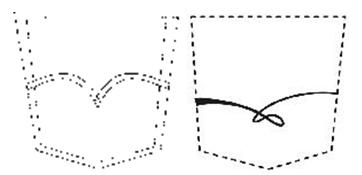
Not identical or nearly identical, so no dilution:
Levi’s “Arcuate” and Abercrombie’s “Ruehl” stitch designs
In 2007, Levi Strauss & Co. sued Abercrombie & Fitch Trading Company in the Northern District of California for trademark infringement, unfair competition, and dilution. On Dec. 22, 2008, a jury rendered a verdict in Abercrombie’s favor on the infringement and unfair competition claims. With the parties’ consent, the jury provided advisory opinions on certain factual issues related to the dilution claim. On April 22, Judge Jeffrey White rendered the court’s findings of fact and conclusions of law on Levi’s dilution claim. In summary, the court found that the subject marks (depicted above) were not “identical or nearly identical,” so Levi could not prevail on its dilution claim.
The court found: “The advisory jury found that [Abercrombie’s] Ruehl design and [Levi’s] Arcuate mark were not identical or nearly identical. In order to be nearly identical, the two marks must be similar enough that a significant segment of the target group of customers sees the two marks as essentially the same. ‘In the dilution context, the ‘similarity of the marks’ test is more stringent than in the infringement context.’
“The evidence demonstrates [that Levi] has expended significant amounts of money advertising the Arcuate mark. Dr. Snood’s Recognition Survey also lends support to the conclusion that the Arcuate mark is recognized by the public. However, even if the Arcuate mark is a strong and distinctive mark, this is not a case where the two marks at issue involve only minor differences, which might weigh in [Levi’s] favor. A & F also has not incorporated the Arcuate mark into the Ruehl design as a ‘separate, visually identifiable element.’
“… Here, the Arcuate mark consists of two parallel lines stitched in two symmetrical arches that meet at a point in the middle of the back pocket. In contrast, the Ruehl design is not ‘virtually indistinguishable’ from the Arcuate mark. Rather, it consists of an embroidered script ‘R’ that was flipped upside down and the legs extended to the edges of the pocket. The Ruehl design also sits lower on the pocket, and the right and left back pocket designs create a mirror image of each other. Although the legs of the upside down ‘R’ create a slight arch, the central feature of the design is a unique swooping loop toward the center of the pocket. None of the Arcuate designs in evidence has a ‘dipsy doodle’ or any kind of infinity loop under them. This evidence demonstrates that a significant segment of the target group of customers would not view the marks as essentially the same.”
Given these findings, the court concluded that Levi did not establish that Abercrombie is making commercial use of a mark that is identical or nearly identical to Levi’s Arcuate mark.
The court also adopted the advisory jury’s finding that the Ruehl design was not likely to cause dilution by blurring because Abercrombie did not intend to create an association with Levi’s Arcuate mark.
The case cite is Levi Strauss & Co. v. Abercrombie & Fitch Trading Co., No. 07-3752, 2009 WL 1082175 (C.D. Calif. April 22, 2009) (White, J.).